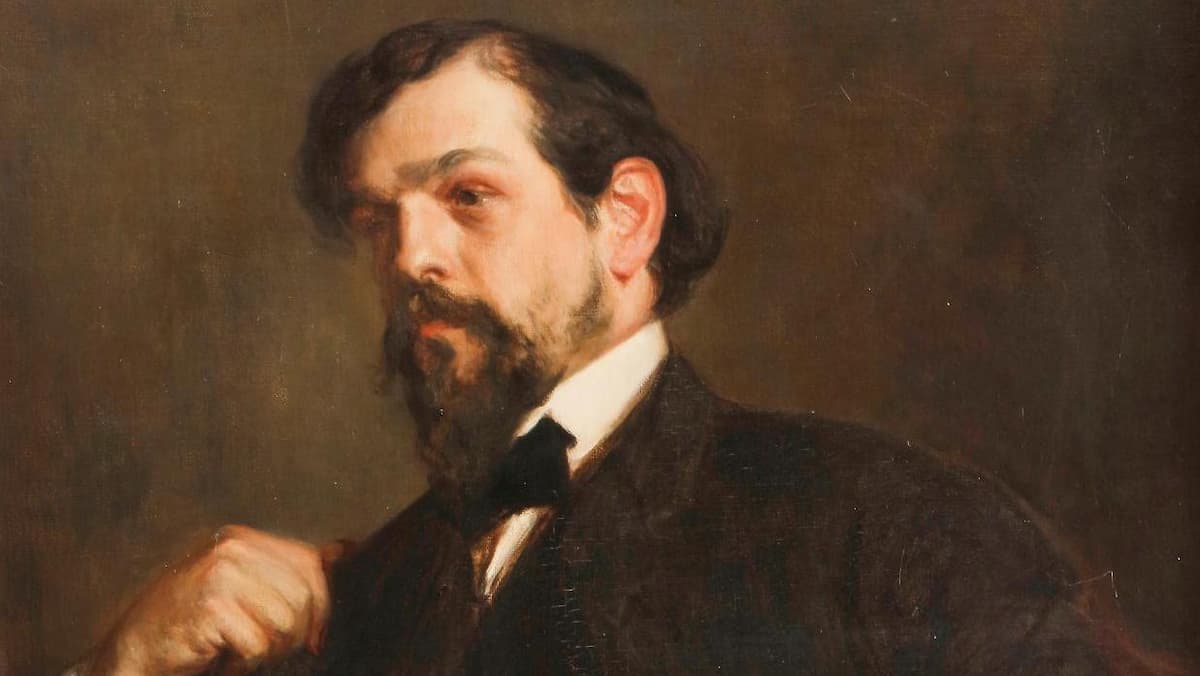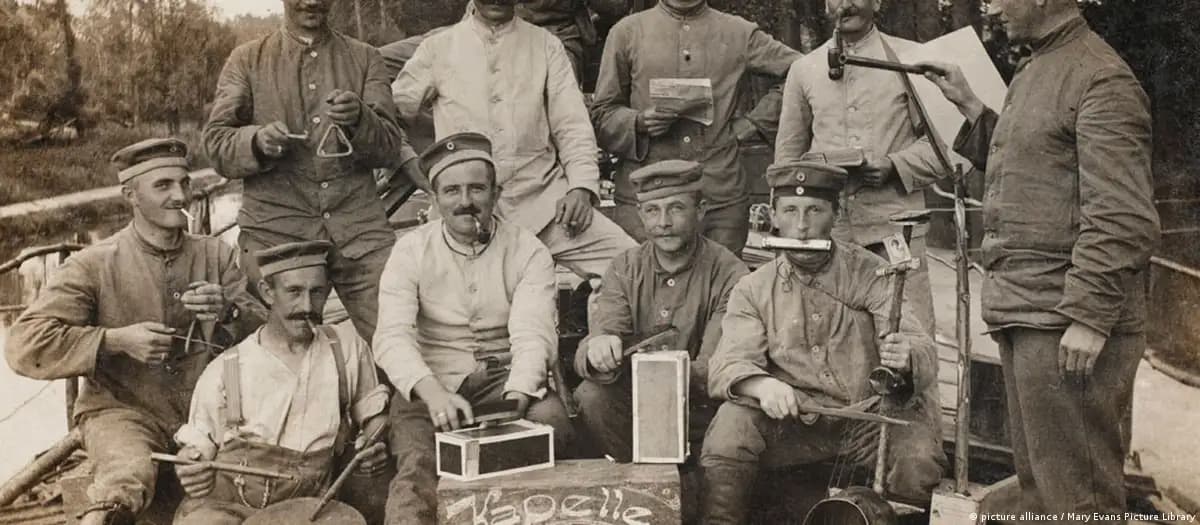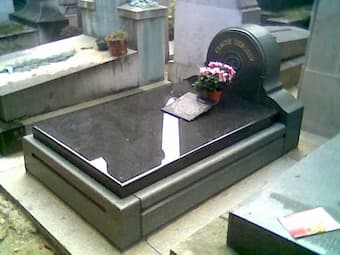Debussy was born in 1862 in Saint-Germain-en-Laye, a suburb of Paris. Over the course of his career, he became one of the twentieth century’s great musical revolutionaries.

Jacques-Émile Blanche (1861-1942), Claude Debussy, 1902, oil on canvas, 95 x 74 cm/37.4 x 29.1 in.
- Debussy’s music is known for its impressionistic style and French identity.
Debussy is often associated with the Impressionist movement in art, which sought to capture fleeting moments and impressions rather than detailed realism.
He also prided himself on his French identity and being a part of French musical history. That pride grew during World War I. He often looked to the work of French poets for inspiration. - He loved using innovative harmonies. He often employed elements in his writing called whole tones and pentatonic scales, traits that gave his music an ethereal dreamlike quality.
- When it came to his personal life, he was a cad. He cheated on his wife soon after they wed, having an affair with a married singer. (Debussy eventually got a divorce and married his mistress.) The resulting scandal made his social life difficult.
Intrigued? Here are ten pieces to get you started exploring Debussy’s life and music:

Claude Debussy with his wife Emma Bardac
Rêverie (ca. 1880-1884)
Although it was composed early in Debussy’s career, Rêverie already shows Debussian hallmarks. Listen for its rhythmic fluidity and freeness.
Years after it was composed, Debussy wrote to his publisher, “I regret very much your decision to publish Rêverie. I wrote it in a hurry years ago, purely for material considerations. It is a work of no consequence, and I frankly consider it to be no good!”
Pianists and listeners disagree. Today, it’s one of his most famous pieces: dreamy, touching, and heartfelt.
Suite bergamasque (1890-91)
Suite bergamasque is a four-movement work for solo piano that evokes all kinds of adjectives: free-flowing, rippling, poignant.
It may not be Debussy’s most mature or layered work, but it gives a fresh, magical impression that the pianist is improvising as he or she goes along.
The third movement was originally known as “Promenade sentimentale.” Later it became known as “Clair de Lune” (“Moonlight”), after a poem by French poet Paul Verlaine. It’s one of the most famous pieces in classical music history.
Prélude à l’après-midi d’un faune (1891-94)
The title of this ten-minute work for orchestra translates to “Prelude to the Afternoon of a Faun.” (A faun is a mythological creature that is half human, half goat.) Debussy was inspired to write about one after reading the poem of the same name by Stéphane Mallarmé.
Here’s Debussy’s own description of the storyline of this piece:
There is a succession of scenes through which pass the desires and dreams of the faun in the heat of the afternoon. Then, tired of pursuing the timorous flight of nymphs and naiads, he succumbs to intoxicating sleep, in which he can finally realize his dreams of possession in universal Nature.
String Quartet (1892-93)
Debussy abandons traditional harmony, constantly shifting into new keys in his String Quartet.
That means that some passages sound unusual – but they also provide thrilling, thought-provoking combinations of sounds.
La mer (1903-05)
La Mer (“The Sea”) is a tone poem that paints a picture of crashing ocean waves. One can practically feel the salty sea spray on your face as you listen.
This work was written during one of the most tumultuous years of Debussy’s life. When he began sketching it out, he was visiting his first wife’s parents. By the time he finished it, he had left his wife, and his mistress was pregnant. In October 1904, his first wife tried shooting herself (fortunately, she survived her suicide attempt). It’s easy to imagine Debussy being tossed around in a veritable sea of emotions during this time.
Critics weren’t impressed by La Mer at first. However, modern audiences have embraced the rolling rhythms and fantastic flourishes of La Mer, and today it’s one of Debussy’s most popular works.
Préludes, Book 1 (1909-1910)
Debussy’s first book of Préludes for solo piano was written quickly, within a matter of months.
They were inspired by all sorts of subjects, drawing heavily on mythology, the natural world, and even architecture.
The first prelude, Dancers of Delphi, depicts an ancient column with sculptures of three women on it. The sixth describes footsteps in the snow. The eighth, La fille aux cheveux de lin, or The Girl With the Flaxen Hair, is possibly the most famous, portraying an enchanting fair-haired maiden.
La plus que lente (1910)
“La plus que lente” in a clumsy English translation means “The more than slow.”
It’s a delicate valse lente, a kind of waltz. It is intensely evocative, summoning conflicting feelings of nostalgia, loss, yearning, and even a bittersweet hope.
Debussy wrote to his publisher about it, “Let’s think of the numberless five-o’-clock teas where assemble the beautiful audiences I’ve dreamed of.” And indeed, it’s easy to imagine a room of lovely turn-of-the-century Parisians while listening to this piece.
Rhapsodie for saxophone and orchestra (1901-1911)
In the early twentieth century, the saxophone was a relatively new instrument, and there wasn’t a lot of classical repertoire available for it.
American saxophonist Elise Hall was determined to change that. So she commissioned a work for saxophone from Debussy.
Debussy was reluctant to write for the saxophone and for Elise Hall specifically. However, after a period of years, he found it within himself to compose a suitably sultry, lush, mysterious one-movement Rhapsodie. It was later orchestrated.
Unfortunately, Debussy had taken so long to write the work that Hall had gone deaf and was unable to play its premiere. But she’ll always be remembered for inspiring Debussy to write one of the staples of the saxophone repertoire.
Jeux (1912-13)
Jeux (or “Games”) is a moody ballet written for the influential, trendsetting company Ballets Russes, which would electrify Parisian audiences with its avant-garde productions in the early twentieth century.
It chronicles the adventures of three children who are playing while they search for a lost tennis ball. Toward the end of the ballet, a mysterious hand throws a ball at them and they flee.
Jeux did not meet the same intense reaction as Igor Stravinsky’s ballet Rite of Spring, which premiered two weeks later, and it got lost a bit in the shuffle. But it’s still worth a listen for Debussy’s joyful use of orchestral color.
It is a technically challenging work to pull off. Debussy instructed the players to change speed no fewer than sixty times over sixteen minutes!
Violin Sonata (1917)
Debussy – as well as all of Europe – was irrevocably changed by the outbreak of war in 1914.
In Debussy’s case, the war coincided with a cancer diagnosis. It wasn’t long before his day-to-day life became extremely difficult.

A troop of musicians from WWI © picture alliance / Mary Evans Picture Library
In the face of war and his own mortality, he became obsessed with the idea of what it meant to be French.
He decided he would celebrate French identity by writing a set of six sonatas. One of them became his violin sonata.
“This work was created not so much for myself, but to offer proof, small as it may be, that French thought will not be destroyed… I think of the youth of France, senselessly mowed down…what I am writing will be a secret homage to them,” he wrote.
The violin sonata is extremely sensual, and almost painfully beautiful at times, but brief. This is the work of a composer at the height of his powers, summing up what he had learned and loved over the course of his life in music.
Conclusion

Debussy’s grave in Passy Cemetery
“It is almost impossible to work, to tell the truth,” he wrote during the war. “One hardly dares to, for the asides of the war are more distressing than one imagines. I am just a poor little atom crushed in this terrible cataclysm.”
Claude Debussy died in March 1918, eight months before the end of World War I. However, his legacy as a musical innovator and as one of France’s greatest composers, lives on.
For more of the best in classical music, sign up for our E-Newsletter
